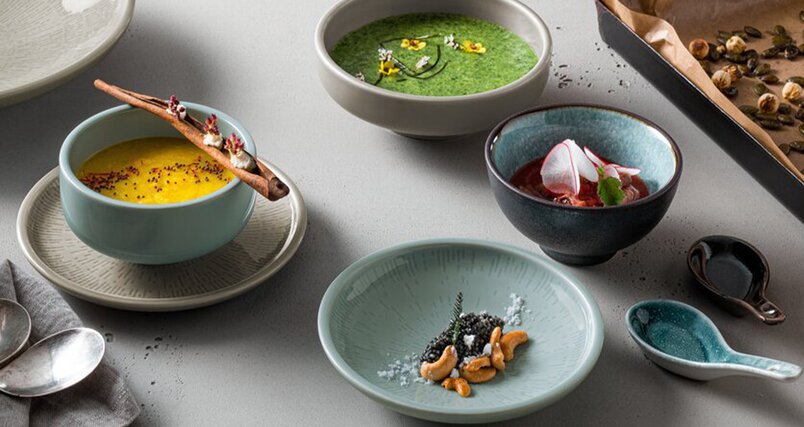High in protein, environmentally friendly and diverse: Insect food will play an important role for the global food supply in the future – according to nutrition experts. Even if edible insects are still an absolute novelty, there are more and more restaurants that experimentally serve their guests their first insect dishes. Read here why insects are considered valuable foodstuffs and what entrepreneurial and culinary potential lies behind the new food trend.
Insect food promotes sustainable nutrition
Food trends come and go – but sustainability in particular has become a central and ubiquitous theme for the food and hospitality industry. Enjoyment is still very much the focus of dining culture, but more and more guests in gastronomy and the hotel industry are paying attention to making their diet more environmentally friendly and using resources more responsibly. Thus, regional and seasonally grown food, organic products or vegan food are not only delicious and healthy, but also more popular than ever before.
This development requires new solutions in order to be able to supply the constantly growing world population with sufficient food. New farmland and production areas in the sense of urban farming can contribute to greater sustainability. Similarly, insect food represents a promising vision for the future. Foods and dishes based on edible insects are sustainable on the one hand and fulfill the need for healthy nutrition on the other.
Edible insects as nutritious food
Insects as food are convincing in three ways: They have a nutty taste and can therefore be used diversely, they are very rich in protein and less harmful to the environment than animal products having a comparable nutritional content. For example, the production of one kilogram of beef causes ten times as many emissions as that of one kilogram of mealworms. Another important point: Concepts such as "from-nose-to-tail", which are designed to promote the total utilization of livestock. In the end, the edible share of cattle is only about 40 percent. With insects, it is around 80 percent, which is twice as high.
With regard to protein content, insects also perform significantly better than meat and fish products. Some grasshopper species, for example, have twice the protein content of beef and chicken. Even nuts and legumes, which are popular in the vegan diet, are significantly lower in protein than insects. For this reason, especially athletes like to use protein bars made from mealworms and other insects. Apart from nutritious protein, edible insects are also rich in healthy omega-3 fatty acids, B vitamins, minerals and trace elements.
These insects can be eaten
As part of the Europe-wide Novel Food Regulation, mealworms became the first edible insects to be approved in 2015. Since then, over 2,000 edible insect species followed. The best known among them are the following:
- beetles
- caterpillars
- bees
- wasps
- ants
- locusts
- crickets
- bugs
- cicadas
- silkmoths
However, before edible insects can establish themselves as a common foodstuff, the questions of how to ensure animal welfare and what hygiene standards are required for flawless mass production must first be clarified. There is a need for discussion especially on the use of medications, feed quality and the animals' sensitivity to pain.
Insects food as a specialty in gastronomy
The burger chain "Hans im Glück" has successfully proven that guests of gastronomic establishments actually buy or order insect dishes. During an 8-week test period, the "Übermorgen" insect burger was so successful that it was served at a total of 60 of the system caterer's locations. Despite such positive sales figures in restaurants and likewise in retail stores, many consumers still see edible insects as taking quite a bit of getting used to. However, experts are certain – insects will become established as a global foodstuff in the future.
In countries such as China, Thailand, Mexico and Nigeria, insect food has been an integral part of the menu for decades. In Germany, on the other hand, edible insects have not yet really been able to gain acceptance. This opens up huge potential for restaurateurs who dare to put insects on their menus. Innovative insect dishes can become a unique selling point that sets restaurants apart from the competition and attracts the interest of guests. Since insect food is rarely found in restaurants, curious guests will gladly travel long distances to taste insects.
Courageous restaurateurs can thus expand their target group and, with a bit of luck, also attract (local) media attention. Before insect dishes become a permanent part of restaurant menus, it is worthwhile to conduct a short test phase first. In this way, even skeptics and critical guests could be given the chance to try out the new offer.
Insect dishes: Ideas for restaurants
Whether in savory dishes or desserts, fine dining or fast food, insect dishes are highly versatile. An absolute classic already involves deep-fried grasshoppers. Even beyond that, there are numerous preparation methods such as barbecuing, steaming or deep-frying that make edible insects a real specialty in your restaurant. We present a few delicious ideas:
- deep fried grasshoppers in batter
- crunchy insect toppings for salads and fries
- bread crackers with aioli and mealworms
- roasted crickets with garlic
- trail mix with insects
- insect tarte flambée
- insect burger with chickpeas and buffalo worms
- insect protein shakes
- buffalo worm honey banana
- strawberry nut ice cream with insect protein
- buffalo worms with chocolate or caramel











